Union of Bulgaria and Romania
The union of Bulgaria and Romania (Bulgarian: Съюз на България и Румъния, romanized: Sǎjúz na Bŭlgariya i Rumŭniya; Romanian: Unirea Bulgariei cu România) was a project for the unification of Bulgaria and Romania into a common state. This would be accomplished under a federation, a personal union or a confederation. The idea had great support, especially in Bulgaria, and there were several opportunities to realize it. Usually, proposals came from Bulgarians and it was the Romanians, who would have composed the ethnic majority, the ones that were supposed to govern. Nevertheless, it ultimately failed to appear mainly due to the differences between Bulgarians and Romanians and the opposition from external powers like Austria-Hungary and especially Russia.
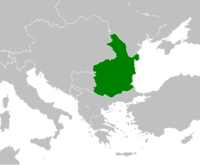
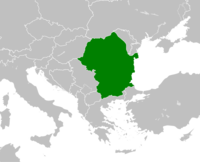
This idea had its precedents. Bulgarians and Romanians first lived together under the rule of the First Bulgarian Empire, which extended its power north of the Danube. After the fall of this state would come the Second Bulgarian Empire, established through the cooperation of Bulgarians and Vlachs (Romanians). The empire would also be defeated, this time by the Ottoman Empire, which ruled territories populated by Bulgarians and Romanians for centuries. Later, a popular concept emerged in the Balkans: the federalization of the region, aimed at fighting nearby empires and solving conflicts between its peoples. The idea eventually spread in Bulgaria and Romania, gaining certain support. Several proposals were made, including one by Georgi Sava Rakovski. After the establishment of an autonomous Bulgarian principality in 1878, projects with Romania were enhanced. In fact, during the search for the first modern Bulgarian prince, several Romanian nominations came out. These were Carol I, monarch of Romania, and Gheorghe G. Bibescu, son of a Wallachian prince. However, the one who ended up being elected was Alexander of Battenberg, of German origins.
Alexander had good relations with Romania, but he was forced to abdicate in 1886 after a period of political turmoil in Bulgaria. This was caused by Russia, which intended to extend its influence over the country. However, Stefan Stambolov, a Russophobe (name of those Bulgarians who opposed Russian policies), ended up taking power. The regent Stambolov tried again to establish a personal union with Romania, and negotiations were conducted. Carol I would be the head of such state, which would have either two separate governments or a single united one. Carol I had interest in becoming ruler of Bulgaria as well, but Russia strongly opposed this. At the end, it threatened Romania with the breakdown of diplomatic relations and even with military invasion, forcing Carol I to reject the offer. Again, a German prince, Ferdinand I, was elected prince of Bulgaria in June 1887. New approaches were attempted decades later, in the communist era, especially by Georgi Dimitrov, but they all met strong rejection from the Soviet Union. Joseph Stalin, its leader, deemed the proposal as impossible.
A Bulgarian-Romanian union was thus never established. The reasons for this were the disapproval of several great powers, the differences in the national goals of the Bulgarians and Romanians and the lack of actual interest or even opposition between each other. In addition, the idea of federalization of the Balkans, which had great support in its time, lost strength all over the region after the conflicts of the beginning of the 20th century and the violent breakup of Yugoslavia. However, the emergence of the European Union, of which Bulgaria and Romania have been members since 2007, has revived such an idea, which could once again be considered in the future.
Background
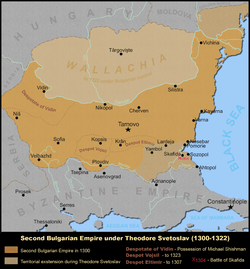
The Bulgarians and Romanians have already lived under a common state on several occasions.[1][2][3] The first time was in 680, when the Bulgars, a Turkic people from the steppes, crossed the Danube and later established a state in the area, with capital at Pliska. They began to assimilate into the Slavic culture brought there one century earlier, thus giving rise to the modern Bulgarian people. Their state, the First Bulgarian Empire, would reach a great territorial expansion north of the Danube, expanding up to the Tisza River and covering basically all the territory of present-day Romania during the 9th century. The Bulgarians strongly enforced Slavic and Christian influence and culture over the Daco-Romans, the ancestors of the Romanians.[1] However, this state dissapeared in 1018.[4]
In the 12th century, there would be an attempt to restore the empire: the Uprising of Asen and Peter, which ended in the apparition of the Second Bulgarian Empire. This rebellion is thought to have had a large Vlach (Romanian) participation, especially in the initial phase. The Vlachs were also decisive during the creation of the new empire. In fact, some sources claim that its first leaders, the brothers Ivan Asen I, Kaloyan and Peter II, had Vlach origins.[5] Moesia, which is the region where the rebellion began, had a high Vlach population at the time.[2] Over time, the Vlachs would lose their relevance, just like the Turkic Bulgars in the first empire.[6]
The Second Bulgarian Empire was later used by supporters of a Bulgarian-Romanian union as a common ground between the two, and it is now a matter of debate between Bulgarian and Romanian historians.[7] The country was defeated in the late 14th century by the Turkish Ottoman Empire,[8] which also extended its power over the Romanian principalities of Wallachia and Moldavia afterwards. However, unlike Bulgaria, the principalities were never directly incorporated as provinces, but instead remained as vassal states.[3]
Many years later, in the late 18th century, the proposal to unify the Balkans under one federation appeared and began to gain strength. It was promoted as politically necessary, especially after wars or revolutions.[9] One of the earliest proposals was that of the Greek with Aromanian origins Rigas Feraios during the 1790s, who conceived the establishment of a Greek-ruled united Balkan state that would succeed the Ottoman Empire.[10] The Balkan peoples saw unification as an opportunity to oppose the imperialist policies of the great powers, particularly that of the Austrian (or Austro-Hungarian) and Ottoman empires, to ensure a more independent and stable development and also to resolve the conflicts between the nations of the region. Proposals included uniting the Balkans alone (Balkan Federation) or with other neighboring nations (Danube Federation), as well as the union of the Balkan Christians or only of the South Slavs of the zone. The main advocates were intellectuals, revolutionaries and politicians from both right and left wing. The way this would be accomplished included a federation, a confederation, a federal monarchic union and a federal republic. There also was the personal union, as it was a period where monarchies were numerous.[11]
In the case of the Bulgarians and Romanians, they were already familiar with the concept of national unifications. Bulgaria united with the Ottoman autonomous province of Eastern Rumelia in 1885, remaining in personal union with it until 1908, when Bulgaria became fully independent. On the other hand, the Romanians usually consider the brief union of the principalities of Wallachia, Moldavia and Transylvania of 1600 under Michael the Brave the first Romanian national union. Romania itself was the product of a personal union, that of Wallachia and Moldavia between 1859 and 1862 under the prince Alexandru Ioan Cuza.[12]
History
Initial proposals
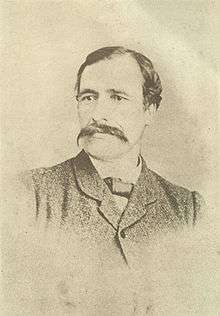
During the 19th century, the idea of federalization was present on the minds of both Romanians and Bulgarians. The Romanians desired to accomplish the independence, national liberation and unification of the Romanian nation, and notable supporters were Nicolae Bălcescu, Dimitrie Brătianu, Mihai Eminescu and Aurel Popovici, who either suggested the integration of Romania into a larger Balkan state or the federalization of the Austrian or Austro-Hungarian Empire in favor of the Transylvanian Romanians. On the other side, the Bulgarian liberation movement of the 19th century, with similar goals to the Romanians, was very focused on allying or uniting with practically all its neighbors to accomplish them, be they Romanians, Serbs, Greeks and even Turks.[13]
The Bulgarian revolutionary Georgi Sava Rakovski advocated for unity among the Balkans to confront and liberate themselves from the Ottoman Empire. However, he was disappointed by the uncooperative nationalist attitude of the Greek and Serbian ruling elites. He went to Bucharest in late 1863 and saw the policies against the influence of the Ecumenical Patriarchate of Constantinople and for independence from the Ottomans that were taking place in the Romanian United Principalities, perceiving the country as a favorable option for the Bulgarians.[14] Thus, in 1864, in the bilingual newspaper Badushtnost (Viitorulǔ in Romanian), Rakovski started talking about the relations between Bulgarians and Romanians, emphasizing that they had always been full of "brotherly love and union" and that cooperation between the two was necessary. He started calling for a Bulgarian-Romanian rapprochement based on equality. He also mentioned the Second Bulgarian Empire as a "strong state" in which Bulgarians and Romanians lived together. It is likely that Rakovski wanted a reestablishment of this empire. This newspaper intended to defend the rights of Romanians and Bulgarians against the Ottoman Empire and the Greek Constantinople Patriarchate. [13]
It is not clear what were the plans of Rakovski for a hypothetical Bulgarian-Romanian union, but future historians have described that he sought a "Bulgarian-Vlach dualism" model. Rakovski developed good relations with the Romanian prince Alexandru Ioan Cuza. However, Cuza was deposed in February 1866 by a coalition (known as the "monstrous coalition") of conservatives and radical liberals. Concerned about a possible Ottoman retaliation, they began to search for allies. One option was Rakovski, but they later learned that he was close to the prince, so they allied themselves with Ivan Kasabov. Being a former associate of Rakovski, Kasabov proposed that Romania supported a Bulgarian rebellion in the Ottoman Empire (since a Bulgarian entity did not yet exist) to divert attention from the coup in Bucharest. This was settled in one document, the "Act for Sacred Coalition between Romanians and Bulgarians". The Bulgarian Committee in Bucharest had to lead two other committees in Serbia and the Ottoman Empire, support them until they had funds on their own and, after the defeat of the Ottoman Empire, establish "autonomous and independent states" that would unite as one "confederation". However, this document was never signed and the Romanian liberals withdrew from the alliance after their government was replaced by Carol I, who became prince in May 1866.[15]
Another project for a union involving Bulgaria and Romania was that of Lyuben Karavelov. He intended a union of all the South Slavs and Romania, Albania and Greece. In the newspaper Nezavisimost, he presented his ideas, an "Eastern federation" composed of three cores: Serbia (including Bosnia and Montenegro), Bulgaria (with the regions of Moesia, Thrace and Macedonia) and Romania, with an Albanian entity and with Constantinople as a "free city". Greece would also be in if it accepted to give up on the recovery of former Byzantine lands. Karavelov made partition plans for the Ottoman and Austro-Hungarian territories. It would be a federation on the model of the United States and Switzerland. Another Bulgarian with a proposal was Vasil Levski. He wanted a "Balkan Democratic Republic" with an equal population made up of Bulgarians, Serbs, Montenegrins and Romanians.[16] The Bulgarian journalist and poet Hristo Botev supported a South Slavic or Balkan union, being against a dual state with the Turks. Regarding Romania, Botev said that their governments "did not particularly love the Slavs" and that Romania was a "product of the Western policy, led by France, which wanted to put a barrier to Eastern Pan-Slavism".[17]
Bulgarian unification projects aimed to solve the Bulgarian church and state questions. This was encouraged by the Russian Empire, the Western powers, or other movements (such as anti-Russian Polish emigrants).[18] Due to interests against the Ottoman Empire, relations between Bulgarians and Romanians considered the option of unification several times between the 1860s and 1870s. However, both peoples had different interests and goals. The Bulgarians pretended to obtain a state, while the Romanians already had their own; the Bulgarians belonged to the Slavic group while the Romanians identified as Latin; the Bulgarians intended to establish themselves in the Balkans while the Romanians had interests in Central Europe; and others.[17] Furthermore, cooperation between Balkan countries in general was hampered due to their great ambitions, which affected the considered "late" Bulgarian national movement. For example, in the series of Serbian agreements and treaties signed in 1866–1868 for an alliance against the Ottomans (known as the First Balkan Alliance), it was suggested that Romania would receive eastern Bulgaria up to the Ruse–Varna line, while Serbia would receive the rest.[18] However, the Romanian Government rejected this proposal, action that was later appreciated by Bulgaria.[19]
Search for a Bulgarian prince
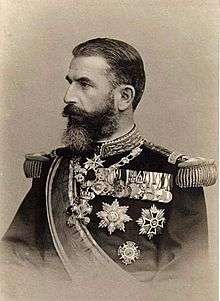
With the emergence of Bulgaria as an autonomous (but not independent) principality in 1878, the mostly federalist proposals with Romania were replaced by the possibility of a personal union. Bulgaria, which appeared after the Russo-Turkish War of 1877–1878 against the Ottomans, was looking for candidates for the Bulgarian throne. Carol I, Prince and later King of Romania since 1866, had already been envisioned by some as the most suitable person for this. Carol I had gained prestige as commander-in-chief of the Romanian Army in the war (where Romania had also participated alongside Russia), which ended in the country's full independence as determined by the Treaty of Berlin.[12]
According to Romanian sources, during the end of the war, Nikolay Pavlovich Ignatyev, Russian diplomat in the Ottoman Empire, "had whispered to Prince Carol I to assume the liberated Bulgarian land under his control", this allegedly never happening due to the Romanian-Russian dispute over Southern Bessarabia. However, according to the notes published by Ignatyev himself, Carol I "had wanted to be elected in Bulgaria" and Prime Minister Ion C. Brătianu supported him in this. Ignatyev said that the intention of the Romanians was "to establish a personal union between Bulgaria and Romania in order to use the former to their own advantage".[20]
Before the election of the first Bulgarian prince started, Carol I was among the nominations. The main intention of his supporters was to establish a dual Bulgarian-Romanian state. According to the Bulgarian historian Simeon Radev, the United Kingdom supported this idea to counter Russian influence in the region. The Bulgarian politician Marko Balabanov stated that in April 1879, the Englishman William Palgrave was trying to convince him and other Bulgarians of the advantages and importance of a union with Romania. Balabanov responded by saying that no decision would be made without Russian consent.[21] Austria-Hungary and Russia opposed the idea, probably due to concerns that a new state would become a competitor in the region.[22] Furthermore, Bulgarian press stated that the Romanians would hardly defend Bulgarian interests and their national unification.[21]
Carol I was not, however, the only Romanian proposal for the Bulgarian throne. The naturalized Frenchman with Romanian origins Gheorghe G. Bibescu, son of Gheorghe Bibescu, a former Wallachian prince between 1843 and 1848, was also discussed. Backed by the French politician Léon Gambetta and other Austrian politicians, he introduced himself as candidate and sent envoys to Bulgaria. Furthermore, supporters of Bibescu also emerged from the Bulgarian side: Svetoslav Milarov, who published the newspaper Balgarskiy lev in Veliko Tarnovo (Bulgaria); and Hristo Bachvarov and D. K. Popov, authors of the newspaper Balgarin issued in Giurgiu (Romania). Both newspapers wanted Bibescu to be the new prince of Bulgaria. In fact, the editors of Balgarin published a pamphlet in Vienna evoking the high qualities of the candidate and saying that Bibescu would do the same as his father did in Wallachia, that is, remove the "legacy of the bad Turkish administration and the Phanariot Caimacams". Pro-Bibescu propaganda stated that he was a descendant of boyars (nobles) from Veliko Tarnovo, capital of the Second Bulgarian Empire.[23]
However, there were also opponents of Bibescu, such as the newspaper Maritsa or various Bulgarian political circles. The Bulgarian politician Petko Karavelov said "Prince Bibescu was not a Bulgarian prince, but he would hardly be honored even to be a head of stable of the future Bulgarian prince". In the end, neither Carol I nor Bibescu were discussed in the assembly for the election of the Bulgarian throne[23] and the German prince Alexander of Battenberg was elected on 17 April 1879 and approved by the great powers and the Ottoman Sultan.[21] Later, it was also proposed that Carol I adopted Alexander to unite the two countries, but the German Empire and Austria-Hungary rejected the idea.[24]
Bulgarian crisis of 1886–1887
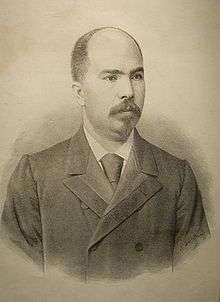
During Alexander's reign, relations between Bulgaria and Romania remained good, reinforced by their opposition to Russian influence. According to Brătianu, who had been in a meeting with Carol I and Alexander in May 1886, the latter suggested the creation of a Balkan confederation in which Carol I would be the head of state and commander-in-chief of the army. The reason for this would be due to the negative reactions from Russia and other powers that followed after the unification of Bulgaria and Eastern Rumelia in 1885,[24] as well as to liberate the region of Macedonia from Ottoman rule.[19] Supposedly, this state would have two separate governments but a common military command in case of war.[25] Brătianu comunicated this to the Bulgarian diplomat Grigor Nachovich. These claims were later denied by Bulgaria, although the friendship between Bulgaria and Romania and the desire for a Balkan confederation was confirmed.[24]
Between 1886 and 1887, Bulgaria would suffer a crisis. Russia accused Alexander of opposing the country, effectively dividing the population of Bulgaria between Russophobes (supporters of Alexander) and Russophiles (supporters of Russian policies). The crisis began on 9 August 1886, when Russophiles made a coup that forced Alexander to abdicate, this being followed by another coup by Russophobes that restored Alexander as monarch. However, due to Russia's disapproval of the events, Alexander abdicated again on August 25. Bulgaria, still controlled by Russophobes, had Stefan Stambolov as regent, who took power. Between August 1886 and June 1887, a new search for a prince who could rule Bulgaria began.[26] This made a personal union between Bulgaria and Romania again possible.[24] Around 20 candidates were discussed, including the neighbouring monarchs of Romania, Serbia and the Ottoman Empire,[27] as well as Montenegro.[28] Again, Russia and Austria-Hungary disapproved this due to fear of the establishment of a large state in the region.[27]
The initiative of a Bulgarian-Romanian union was received with enthusiasm in Bulgaria, either by the press, by politicians or by the citizens themselves. It was seen as the opportunity to decisively break Russian influence in the Balkans.[25] Still, Carol I was not among the leading candidates, although he was more popular than the sovereigns of Bulgaria's other neighbors. The regency, and especially Stambolov, supported initiatives for a Bulgarian-Romanian personal union.[27] Negotiations were held in 1886 to determine how would a dual Bulgarian-Romanian state be like. It was agreed that the country would be under the rule of Carol I, and ethnic Romanians would occupy the main positions of the ministries of defense. According to the Romanian historian Alex Mihai Stoenescu, this was supported by Germany, the United Kingdom and even Austria-Hunagry at some point, although France stayed on the Russian side. Stoenescu thought this powerful Bulgarian-Romanian state with control of the eastern Black Sea could act as a buffer state, which, added to the formation of states in the Western Balkans and the preservation of Greece in the Western sphere of influence, could have even prevented World War I.[25]

The regents hoped that a union between Bulgaria and Romania would not only solve the crisis, but would be the first step towards a future strongly anti-Russian Balkan confederation.[27] Whether this was true is questionable.[29] They turned towards the British diplomat in Bulgaria, Frank Lasels, since the United Kingdom vehemently defended the country's anti-Russian policies. However, he recommended them to abandon the idea, since Carol I, being king of an independent country, would not accept the vassal status the prince of Bulgaria still had towards the Ottoman Empire[30] (Bulgaria appeared in 1878, but did not gain independence until 1908).[12] Afterwards, Stambolov began a new series of negotiations in October 1886 for a Bulgarian-Romanian confederation, this time with a single government. They would extend until May 1887. Meanwhile, Russian actions in the two countries continued. On September 4, there was an attack against Brătianu. It is thought that Russia could have been involved in this, since it happened shortly after the events in Bulgaria. This had an aggressive response from the Romanian public, which began attacking newspaper editorial offices considered "Russian agents". Regarding Bulgaria, in November 1886, Russia broke relations with it until 1896.[25]
Romania throughout the crisis adopted a neutral position due to the intensification of the great powers' struggle for influence in Bulgaria. It offered Alexander asylum but also allowed Russophiles who had caused the coup to enter the country. In late 1886, Carol I recommended Bulgaria to reconcile with Russia and choose a Bulgarian native as prince. According to Simeon Radev, Carol I carefully observed his own movements towards Bulgaria to not become a direct opponent of Russia.[31] Furthermore, there was a possibility that Romanians would oppose a possible union due to fear that the Bulgarians could influence Romanian politics and to preserve Northern Dobruja, with a Bulgarian ethnic minority, under Romanian control. Such was the position of a Romanian minister whose identity was never revealed.[29]
Following the rejection of the Ottoman Sultan of a Bulgarian-Turkish dual state, the regents again turned towards Romania in February 1887. They first made a proposal to the Romanian consul in Ruse, and on February 27, Stambolov went to the Romanian embassy in Sofia and stated that he wanted to see Carol I as ruler of Bulgaria.[28] However, no official request was made as he did not want to "expose" Romania to the Triple Alliance. The latter was a secret alliance between Germany, Austria-Hungary and Italy formed in 1882 and to which Romania had joined a year later.[19] After this, the Romanian political activist Zamfir Arbore revealed Russian spy projects in Romania. The great powers demand Russian explanations, further weakening Russian influence on the Balkans.[25]
On 10 June 1887, Russia threatened Romania with the breaking of diplomatic relations. Carol I contacted German and Austro-Hungarian representatives, who informed him that Russia will invade Bulgaria and Romania if he does not reject the Bulgarian crown offer.[32] Russia saw such proposal as a violation of the Treaty of Berlin. Carol I, despite his interest on a union with Bulgaria,[29] informed on June 15 to Russia that he would not accept a Bulgarian-Romanian state without Russian consent, thus ending the union project.[32][29] At the end, the German Ferdinand I of Bulgaria was elected as prince in 25 June 1887.[27] This did not end the subject in Romania; on July 16, on its 12th issue, the Romanian newspaper Sentinela published the article Unirea Bulgariei cu România în persoana Regelui Carol I ("The union of Bulgaria with Romania in person of King Carol I") about the Bulgarian offer of a dual state.[33]
Communist period
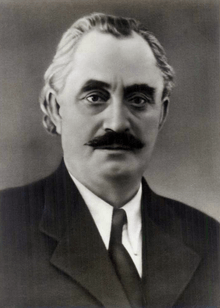
For the following decades, the federalization of the Balkans remained as a prominent idea.[29] However, the outcome of the Balkan Wars and World War I damaged its popularity, dividing the Balkans between "winner" and "loser" countries.[34] This also included Bulgaria and Romania.[35] In 1913, during the brief Second Balkan War, Romania joined the war against Bulgaria and took Southern Dobruja, confirmed by the Treaty of Bucharest.[36] Both countries would be confronted again in 1916–1918 during World War I,[35] although no territorial changes were made.[37] This rendered any proposal of unification between the two impossible for years.[35] Diplomatic relations in the Balkans began to improve after the signing of the Kellogg-Briand Pact of 1929, in which war was renounced as a state policy, and during the Great Depression. During the 1930s, conferences and the creation of the Balkan Entente in 1934 between Romania, Yugoslavia, Greece and Turkey reactivated the federation idea. The desire in Bulgarians and Romanians to establish a bigger and more powerful state with other countries remained present in some intellectuals and politicians.[34] For example, the Romanian historian Victor Papacostea proposed in 1936 a confederation named "Balkania" under Romanian leadership destined to solve the regional conflicts.[35]
Balkan socialists were particularly interested in a Balkan Federation. These included several Bulgarian (Dimitar Blagoev, Christian Rakovsky, Yanko Sakazov) and Romanian (Constantin Dobrogeanu-Gherea) socialist leaders. Socialists saw unification as a potential solution to imperialism and nationalism in the Balkan countries and as a transition from capitalism to socialism in the region.[35] In 1945, Yugoslavia, which was a kingdom, became a socialist federal republic. Negotiations began between Yugoslavia and Bulgaria in late 1944 and early 1945 to establish a South Slavic Federation. However, the negotiations failed due to the dispute over the region of Macedonia and discrepancies in the status of Bulgaria with respect to Yugoslavia. Negotiations started again in 1947 and early 1948, when a Balkan or Balkan-Danubian Federation was also proposed with the possibility of Romanian participation.[38]
The pro-Soviet and pro-communist governments established in Bulgaria and Romania somewhat improved the previously damaged relations between the two.[38] In fact, Bulgaria had already recovered Southern Dobruja earlier in 7 September 1940, when the Treaty of Craiova was signed.[39] However, there continued to be national and political differences between the countries which affected the subject of federation. In November 1946, the Romanian journalist Gheorghe Zaharia interviewed the Bulgarian Prime Minister Georgi Dimitrov. The topic of the situation of the Balkans came up, and Dimitrov said Romania could join a possible future Balkan Federation. However, although the interview was supposed to be published in the newspaper Scînteia, permition was revoked. The interview angered Gheorghe Gheorghiu-Dej, leader of the Romanian Communist Party, probably because he did not want to irritate the Soviet Union.[40]
Another federalization idea with Bulgarian and Romanian participation appeared on 15 and 16 January 1948, during Dimitrov's visit to Bucharest in which the Bulgarian-Romanian Treaty of Friendship, Cooperation and Mutual Assistance was signed. Dimitrov wanted to speak to the Romanian lawyer and journalist Petre Pandrea. Pandrea was a relative of the communist activist Lucrețiu Pătrășcanu, and according to him, Romania should advocate for neutrality, with Switzerland being the example to follow (thus appearing the concept of "helvetization"), and not for the Romanianization of the Balkans.[41] Dimitrov supported the application of his ideas for all the Balkans and later said the phrase Dreimal Schweiz! ("three times Switzerland!" in German).[42] Pandrea was convicted in 1959, being accused, among other things, of involvement in a plot for the "helvetization of Romania".[41] Once imprisoned, he said after three months that Dimitrov meant the incorporation of the neutrality concept in Romania, Bulgaria and Yugoslavia. According to the Bulgarian historian Blagovest Nyagulov, this can also be interpreted as the subsequent federalization of the three countries following the Swiss model.[42]
When Dimitrov returned from Bucharest, he gave a press conference in which he proposed a Balkan and Danubian confederation (thus including Bulgaria and Romania) in which Poland and Czechoslovakia could later join as well. However, Joseph Stalin, leader of the Soviet Union, said that this statement was "harmful" for Moscow. Dimitrov's words were criticized on January 18 by the newspaper Pravda, and on February 10, a meeting was organized between Bulgarian, Soviet and Yugoslav representatives in which Dimitrov ended up saying that his statements were "harmful and wrong" and that the event would not be repeated, probably not being sincere.[43] The reasons for this Soviet reaction were to ensure control over its satellite states and because Dimitrov's proposal could serve the United States to oppose the emerging Eastern bloc.[44] Stalin also precluded the possibility of a federation between Bulgaria and Romania or the improvement of relations between the two, something to which he was against. According to him, a union between the two countries was "unthinkable" and "stupid" since there were not "any Bulgarian-Romanian historical ties", repeating the Russian opposition to a Bulgarian-Romanian union once again.[45]
In the end, any attempt at a federation involving both Romania and Bulgaria disappeared: Soviet influence over Romania increased significantly in late 1947 and early 1948 and the Tito-Stalin split later in 1948 forced Bulgaria and Yugoslavia to forget a potential South Slavic Federation.[46]
Aftermath
Failure
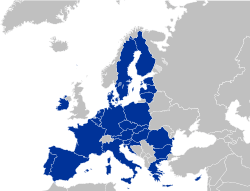
Over time, the idea of federalizing the Balkans fell. The Balkan Wars and World War I shadowed the possibility and fueled nationalism and geopolitical conflicts. A federation was only implemented once, in the socialist Yugoslavia. This state failed and its dissolution was violent and dramatic, making a pan-Balkanic federation even less popular and reinforcing the ideas of nation states (culturally homogeneous states).[47]
The situation was common between Bulgaria and Romania. Although both countries shared Orthodox Christianity, strong economic and cultural ties and a desire for independence from the Ottomans, nationalism and the intervention of external powers poisoned the friendship of both countries, and shortly before World War II, it was filled with ethnic and territorial hostilities. During the communist era, although relations improved, the foreign policies of both countries were contrary, with Bulgaria being loyal to the Soviet Union while Romania seeking greater autonomy.[48]
The reasons, therefore, why a Bulgarian-Romanian union failed to appear are several. Unionist proposals always came from the side of the Bulgarians, since Romania would grant them certain political advantages. However, national priorities were not the same.[49] The Bulgarians focused on the Balkans, while the Romanians in Central Europe.[17] Furthermore, these projects were launched as an attempt of liberation and independence (among others), not because of a real interest in the other. The nation state model and territorial claims over other countries were not unusual in the region. Many of the great powers strongly opposed a Bulgarian-Romanian union,[49] either in 1878–1879, when Austria-Hungary and Russia disfavored Romanian candidates for the Bulgarian throne;[22] in 1886–1887, when the same countries opposed the election of a monarch from the neighbors of Bulgaria[27] (with Russia even threatening Romania with military invasion);[32] or in 1947–1948, when Romania had to reject any federative proposal with any other country to avoid Soviet discontent.[40] The fierce opposition, especially from Russia (or the Soviet Union), is probably due to the fear of a strong and influential state that could compete against the great powers or due to the "divide and rule" principle.[23][27][49] Even without external influence, opposition for a possible union arose anyway from both Bulgarians[22] and Romanians.[29]
After the fall of the communist regimes in 1989, old and new disagreements emerged between Bulgaria and Romania. Nevertheless, the accession of both countries in the European Union[48] in 2007[47] has strengthened their relations and cooperation between each other.[48] For example, in 2011, the Bulgarian Prime Minister Boyko Borisov proposed to buy fighter aircraft together with Romania, Turkey and Croatia. On the other hand, Nickolay Mladenov, the then Ministry of Foreign Affairs, proposed unifying the air and naval forces of the country with Romania. Many politicians and military experts have made similar statements, mainly because doing so would make maintenance of aircraft and pilot training cheaper.[50]
The efforts for European integration in the Balkans have provoked comments on a possible federation once again.[47] The European Union and its democratic values impose common visions for the development of its various societies, which may also include a future federation proposal.[49]
Comparison
The following is a comparison of both countries in case unification took place. For convenience and data accessibility, the information is based on recent years rather than the 19th and 20th centuries. Demographic data has been taken from the 2011 censuses of Bulgaria and Romania,[51][52] while economic, geographic and military data originates from CIA's reference resource The World Factbook.[53][54]
| Population (2011) | 7,364,570[55] | 20,121,641[56] | 27,486,211[55][56] |
|---|---|---|---|
| Area | 110,879 km2 (42,811 sq mi)[53] | 238,391 km2 (92,043 sq mi)[54] | 349,270 km2 (134,850 sq mi)[53][54] |
| Density (2011) | 66.42/km2 (172.03/sq mi)[55][53] | 84.41/km2 (218.61/sq mi)[56][54] | 78.70/km2 (203.83/sq mi)[55][56][53][54] |
| Ethnic composition (2011)[lower-alpha 1] | Bulgarians (84.8%), Turks (8.8%), Romani (4.9%), others (1.5%)[59] |
Romanians (88.9%), Hungarians (6.5%), Romani (3.3%) others (1.3%)[58] |
Approximately: Romanians (66%), Bulgarians (22%), Hungarians (5%), Romani (4%), Turks (2%), others (1%)[59][58] |
| Capital | Sofia[53] | Bucharest[54] | Unknown |
| Coastline | 354 km (220 mi)[53] | 225 km (140 mi)[54] | 579 km (360 mi)[53][54] |
| Elevation | Average: 472 m (1,549 ft) Lowest: 0 m (0 ft), Black Sea Highest: 2,925 m (9,596 ft), Musala[53] |
Average: 414 m (1,358 ft) Lowest: 0 m (0 ft), Black Sea Highest: 2,544 m (8,346 ft), Moldoveanu[54] |
Average: 443 m (1,453 ft) Lowest: 0 m (0 ft), Black Sea Highest: 2,925 m (9,596 ft), Musala[53][54] |
| Currency | Lev (BGN)[53] | Leu (RON)[54] | Unknown |
| GDP (2017 estimate) | PPP: $154 billion Nominal: $56.9 billion[53] |
PPP: $483 billion Nominal: $212 billion[54] |
PPP: $637 billion Nominal: $269 billion[53][54] |
| Military size (2019 estimate) | Around 31,000 active personnel[53] | Around 72,000 active personnel[54] | Around 103,000 active personnel[53][54] |
Bulgarian northwest controversy
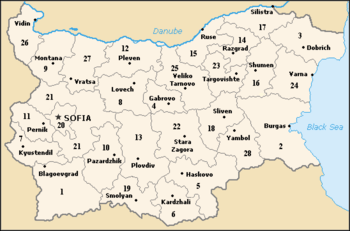
On 4 January 2018, the Bulgarian newspaper Nova published an interview with Boris Kamenov,[60] a Bulgarian construction worker in the Vratsa Province.[61] Allegedly, he had said that residents of northwestern Bulgaria were preparing a referendum to secede from Bulgaria and afterwards, join Romania. The territories in question were the provinces of Montana, Vidin and Vratsa. The main reason was the existing corruption in Bulgaria, with Nova stating that his motivations to join Romania were because "the judiciary is much more democratic and reformed" and because the fight against corruption in general was more efficient. According to the newspaper, Kamenov also pointed out that the people of the northwest had always fought for "true democracy", as it was in that region where the Chiprovtsi and September uprisings began. Another local supporter of the idea said there were no jobs in the region. Nova also said Kamenov wanted "a man like Pudgiemont" for the Bulgarian northwest.[60] The region with the three provinces is the poorest in Bulgaria, with no natural resources and victim of a population exodus.[62]
The news had a great impact and controversy in both Bulgaria and Romania, where the same article from Nova was published by many other newspapers with little to no change in the text. Just a day later, the Romanian journalist Dan Alexe criticized the proposal's unrealism, saying that Boyko Borisov's authoritarian government was not going to allow any referendum, and even if this happened, the legal difficulties for achieving unification with Romania would be very great, making the project almost impossible.[62] Furthermore, later the same day, Kamenov himself stated that his idea had been misinterpreted and deformed by the press. He referred to "independence" from corruption, not from Bulgaria, and mentioned Romania because the judicial system was better there. He said that if he had wanted to join another country, it would have been Germany or Austria. Kamenov complained about the attitude of the press, which assumed that he had already started a request, and the journalists, who were calling him repeatedly for explanations.[61]
See also
- Greek–Yugoslav confederation
- Intermarium
- List of proposed state mergers
- Union of Hungary and Romania
Notes
References
- Hitchins 2014, pp. 16–17.
- Madgearu 2016, p. 74.
- Hitchins 2014, p. 31.
- Madgearu 2016, p. 58.
- Madgearu 2016, pp. 58–59.
- Madgearu 2016, p. 62.
- Nyagulov 2012, pp. 40–41.
- Hitchins 2014, p. 26.
- Nyagulov 2012, p. 37.
- Nyagulov 2012, p. 39.
- Nyagulov 2012, pp. 37–38.
- Nyagulov 2012, p. 46.
- Nyagulov 2012, pp. 39–40.
- Nyagulov 2012, p. 41.
- Nyagulov 2012, pp. 41–42.
- Nyagulov 2012, p. 44.
- Nyagulov 2012, p. 45.
- Nyagulov 2012, p. 43.
- Lupu & Niculae 2017, p. 125.
- Nyagulov 2012, pp. 46–47.
- Nyagulov 2012, p. 47.
- Nyagulov 2012, pp. 47–48.
- Nyagulov 2012, p. 48.
- Nyagulov 2012, p. 49.
- Stoenescu 2010, p. 30.
- Nyagulov 2012, pp. 49–50.
- Nyagulov 2012, p. 50.
- Nyagulov 2012, p. 51.
- Nyagulov 2012, p. 52.
- Nyagulov 2012, pp. 50–51.
- Nyagulov 2012, pp. 51–52.
- Stoenescu 2010, p. 31.
- Petcu 2012, p. 532.
- Nyagulov 2012, p. 53.
- Nyagulov 2012, p. 54.
- Hitchins 2014, p. 150.
- Hitchins 2014, p. 158.
- Nyagulov 2012, p. 55.
- Hitchins 2014, p. 199.
- Nyagulov 2012, pp. 55–56.
- Nyagulov 2012, p. 56.
- Nyagulov 2012, p. 57.
- Nyagulov 2012, pp. 57–58.
- Nyagulov 2012, p. 58.
- Nyagulov 2012, pp. 58–59.
- Nyagulov 2012, p. 59.
- Nyagulov 2012, p. 38.
- Nyagulov 2012, p. 60.
- Nyagulov 2012, p. 61.
- Bâtca 2011.
- Bulgarian census 2011.
- Romanian census 2011.
- CIA World Factbook: Bulgaria.
- CIA World Factbook: Romania.
- Bulgarian census 2011, p. 3.
- Romanian census 2011, p. 1.
- Bulgarian census 2011, p. 28.
- Romanian census 2011, p. 5.
- Bulgarian census 2011, p. 25.
- Borisova 2018.
- Ionescu 2018.
- Alexe 2018.
Cited bibliography
- Hitchins, Keith (2014). A concise history of Romania. Cambridge University Press. pp. 1–327. doi:10.1017/CBO9781139033954. ISBN 9780521872386.
- Lupu, Diana Cristiana; Niculae, Daniel Silviu (2017). "The Balkan Pact – history and modernity". Scientific Research and Education in the Air Force – AFASES. 2: 123–132. doi:10.19062/2247-3173.2017.19.2.17.
- Madgearu, Alexandru (2016). The Asanids: The Political and Military History of the Second Bulgarian Empire (1185-1280). BRILL. pp. 1–359. ISBN 9789004333192.
- Nyagulov, Blagovest (2012). "Ideas of federation and personal union with regard to Bulgaria and Romania". Bulgarian Historical Review (3–4): 36–61. ISSN 0204-8906.
- Petcu, Marian (2012). Istoria jurnalismului din România în date: enciclopedie cronologică (in Romanian). Iași: Polirom. pp. 1–1414. ISBN 9789734630677.
- Stoenescu, Alex Mihai (2010). Istoria loviturilor de stat în România: 1821-1999 (in Romanian). 2. Editura RAO. pp. 1–154. ISBN 9786068255040.
Cited newspapers
- Alexe, Dan (5 January 2018). "De ce nu au cum să se unească trei județe din Bulgaria cu România". Vice (in Romanian).
- Bâtcă, Marius (31 May 2011). "România, Bulgaria și Turcia – avioane de luptă la comun?". Ziua Veche (in Romanian).
- Borisova, Biljana (4 January 2018). "В Северозапада организират подписка за обявяване на независимост". Nova (in Bulgarian).
- Ionescu, Sinziana (5 January 2018). "Boris Kamenov, separatistul din Bulgaria: "Dacă voiam unirea cu altă țară, am fi ales Austria sau Germania, nu România"". Adevărul (in Romanian).
Cited websites
Censuses:
- "Преброяване 2011 (окончателни данни)" (PDF) (in Bulgarian). National Statistical Institute. 2011. pp. 1–50. Archived from the original (PDF) on 22 December 2018.
- "Rezultate definitive ale recensământului populației și al locuințelor – 2011" (PDF) (in Romanian). National Institute of Statistics. 2011. pp. 1–14. Archived (PDF) from the original on 17 July 2013.
CIA's The World Factbook:
- "Bulgaria". The World Factbook. Central Intelligence Agency (CIA). Archived from the original on 13 July 2020. Retrieved 14 July 2020.
- "Romania". The World Factbook. Central Intelligence Agency (CIA). Archived from the original on 25 June 2020. Retrieved 14 July 2020.
External links
